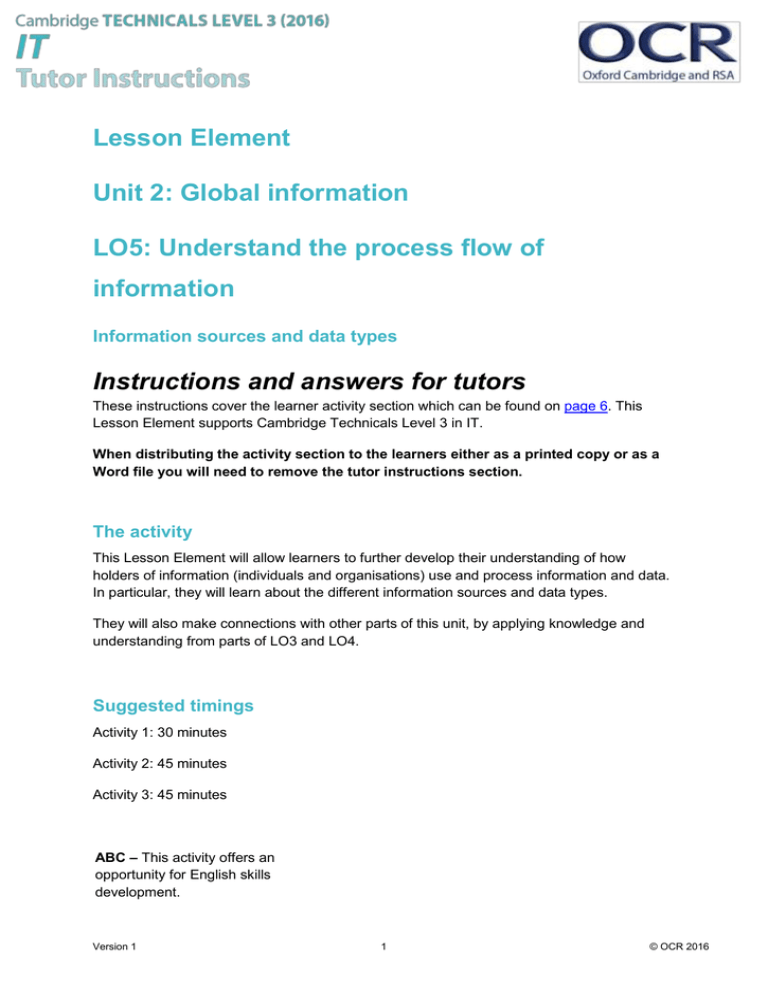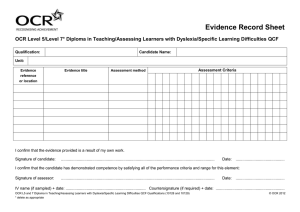Unit 02 - Lesson element - Information sources and data types (DOC, 439KB)
advertisement

Lesson Element Unit 2: Global information LO5: Understand the process flow of information Information sources and data types Instructions and answers for tutors These instructions cover the learner activity section which can be found on page 6. This Lesson Element supports Cambridge Technicals Level 3 in IT. When distributing the activity section to the learners either as a printed copy or as a Word file you will need to remove the tutor instructions section. The activity This Lesson Element will allow learners to further develop their understanding of how holders of information (individuals and organisations) use and process information and data. In particular, they will learn about the different information sources and data types. They will also make connections with other parts of this unit, by applying knowledge and understanding from parts of LO3 and LO4. Suggested timings Activity 1: 30 minutes Activity 2: 45 minutes Activity 3: 45 minutes ABC – This activity offers an opportunity for English skills development. Version 1 1 © OCR 2016 Activity 1 Tutors could start this activity by explaining the following information sources and data types: internal source external source primary data secondary data qualitative data quantitative data. In addition, tutors could refer back to the ‘data versus information’ and the ‘information system structure’ sections of LO3, as these are relevant to this activity. Similarly, so are the ‘quality of information’ and ‘information management’ sections of LO4. Tutors need to make connections between this and the previous learning. Tutors should support learners during the research phase and clarify/correct any misconceptions. Activity 2 Tutors could provide pairs of learners with a collection of cards carrying descriptions of pieces of information (e.g. supplier price lists; the names of employees; expiry date of a medicine; interest rate charged on a loan from a bank). A selection of such cards are shown below; these have been laid out in groups of three, corresponding to one possible information source or data type for each card; below them is a set to be given to learners. In reality, a piece of data will usually fit into more than one such category. For instance, ‘a price list from a supplier’ will provide an external source, will form secondary data and the prices could be described as providing quantitative data. Tutors could display the six information sources and data types from Activity 1 above: internal source; external source; primary data; secondary data; qualitative data; and quantitative data. Tutors could then give learners a complete set of individual cards (18 in all). Learners, in pairs, should develop their understanding of information sources and data types, by discussing and agreeing which of these best describe each piece of information shown on the cards. Learners should write all the ones that apply on the back of each card. Tutors could answer questions and address misconceptions as the pairs of learners are carrying out this task. Version 1 2 © OCR 2016 Possible categorisations of the Information cards Internal Sources Finance department records used by the sales department of the same organisation Analysis by the marketing department of three new products The contact list on my phone External sources Price list from a supplier Financial report from your bank Online survey completed by customers Primary data Foot size measurements taken by a shoe shop Number of purchases made in your shop each day Attendance register taken at the start of this lesson Secondary data Interest rate on a loan from your bank Information given to you by a market research company Feedback received from customers on a third party review website Qualitative data Names of donors to a charity The weather at your location today The colour of a product in stock Quantitative data Expiry date of medicines in a pharmacy Version 1 The total number of learners in a class 3 The speed limit on a motorway © OCR 2016 Information cards to be printed and cut out. One sheet (18 cards) to be distributed to each pair of learners. Foot size measurements taken by a shoe shop Number of purchases made in your shop each day Attendance register taken at the start of this lesson Interest rate on a loan from your bank Information given to you by a market research company Feedback received from customers on a third party review website Price list from a supplier Financial report from your bank Online survey completed by customers Names of donors to a charity The weather at your location today The colour of a product in stock Finance department records used by the sales department of the same organisation Analysis by the marketing department of three new products The contact list on my phone Expiry date of medicines in a pharmacy The total number of learners in a class The speed limit on a motorway Version 1 4 © OCR 2016 Activity 3 Learners should now develop their understanding of information sources and data types by discussing their decisions in larger groups. They should agree which information sources and data types could be appropriate for each example card. The agreed responses from each group should be shared with the whole class. Tutors could facilitate a class plenary to bring this activity to a close noting: What does everyone agree on? Are there good explanations for areas where groups do not agree? We’d like to know your view on the resources we produce. By clicking on ‘Like’ or ‘Dislike’ you can help us to ensure that our resources work for you. When the email template pops up please add additional comments if you wish and then just click ‘Send’. Thank you. If you do not currently offer this OCR qualification but would like to do so, please complete the Expression of Interest Form which can be found here: www.ocr.org.uk/expression-of-interest OCR Resources: the small print OCR’s resources are provided to support the teaching of OCR specifications, but in no way constitute an endorsed teaching method that is required by the Board, and the decision to use them lies with the individual teacher. Whilst every effort is made to ensure the accuracy of the content, OCR cannot be held responsible for any errors or omissions within these resources. © OCR 2016 - This resource may be freely copied and distributed, as long as the OCR logo and this message remain intact and OCR is acknowledged as the originator of this work. Please get in touch if you want to discuss the accessibility of resources we offer to support delivery of our qualifications: resources.feedback@ocr.org.uk Version 1 5 © OCR 2016 Lesson Element Unit 2: Global information LO5: Understand the process flow of information Learner Activity Information sources and data types This Learning Element will allow you to develop your understanding of how holders of information (individuals and organisations) use and process information and data. In particular, you will learn about the different information sources and data types. Whilst working on the activities you will apply the knowledge and understanding you have gained from studying LO3 and LO4. Activity 1 Look at this list of information sources and data types: internal source external source primary data secondary data qualitative data quantitative data. Based on the explanations of your tutor, you should carry out research into the different information sources and data types (listed above). You should produce a definition of each information source and data type, plus find out a few examples of each. This can be recorded in any way that suits you best, but remember that you might need this for revision, later on. Version 1 6 © OCR 2016 Activity 2 For this activity you will be working in pairs. You will be provided with a collection of cards carrying descriptions of pieces of information (e.g. supplier price lists; the names of employees; expiry date of a medicine; interest rate charged on a loan from a bank). You should discuss and agree which of the headings below best describes each piece of information: internal source external source primary data secondary data qualitative data quantitative data. You should write all of the headings that apply, on the back of each card, as most cards could fit in with more than one heading. If you have any questions when you are working on this task, your tutor will be able to help you. Activity 3 You should now discuss your decisions from the paired work in Activity 2 in larger groups. What do you all agree on and where do you disagree? Then you should agree which information sources and data types could be appropriate for each piece of information that you were given. Finally you should discuss all of your ideas as a whole group. Your final decisions should be fed back to the rest of your class. What do you agree about? If you disagree, why is that? Can you explain the reasons? Version 1 7 © OCR 2016

